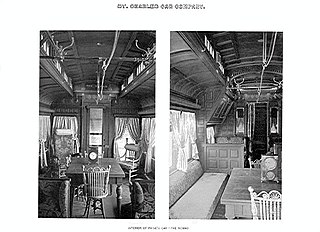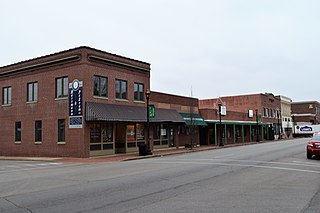
St. Charles Car Company, a railroad rolling stock manufacturing company located in St. Charles, Missouri, was founded in 1872 or 1873. In 1899 it merged with twelve other companies to form American Car and Foundry (ACF). The St. Charles plant became the main passenger car works. With a failing market for steel passenger cars, ACF phased out the St. Charles operation in 1959.
Patee Town Historic District is a national historic district located at St. Joseph, Missouri. The district encompasses 71 contributing buildings and 1 contributing site in the Patee Town section of St. Joseph. It developed between about 1858 and 1939, and includes representative examples of Greek Revival and Italianate style architecture. Located in the district are the separately listed Patee House, a hotel that is a U.S. National Historic Landmark, and Jesse James House. Other notable buildings include the Morey Piro House (1910), Charles E. Herycele House (1903), R. L. McDonald Manufacturing Co. Warehouse (1899), Mrs. Pemetia Cornish Duplex, Fred Wenz Store Building (1903), Fire Station #5 (1939), German Salems Church, and Matthew Ziebold House (1895).

LaSalle Park is an integral part of the three-neighborhood "Old Frenchtown" area—LaSalle Park, Lafayette Square and Soulard—bordering the southern edge of downtown St. Louis. It was formed as a "new" neighborhood, legally distinct from the larger Soulard district, through the efforts of the city of St. Louis, Missouri and Ralston Purina, which has its world headquarters in LaSalle Park.

The Richmond Railroad Station Historic District is a group of historic commercial buildings and national historic district located at Richmond, Wayne County, Indiana.

Clarksville Historic District is a national historic district located at Clarksville, Pike County, Missouri. The district encompasses 65 contributing buildings in the central business district and surrounding residential sections of Clarksville. It developed between about 1840 and 1930, and includes representative examples of Greek Revival, Italianate, and Queen Anne style architecture. Located in the district is the separately listed Clifford-Wyrick House. Other notable buildings include the City Hall (1910), Sentinel Building (1867-1871), Clifford Banking Company, La Crosse Lumber Company (1923), Presbyterian Church, Methodist Church (1906), Masonic Temple (1903), and Clarksville Public Library (1910).

The East Columbia Historic District is a national historic district located at Farmington, St. Francois County, Missouri. The district encompasses 11 contributing buildings in the central business district of Farmington. It developed between about 1879 and 1954, and includes representative examples of Late Victorian, Beaux Arts, and Bungalow / American Craftsman style architecture. Notable buildings include the Tetley Jewelry Store, Andy Hahn Building, Lang and Holler Building, U.S. Post Office, and Henry C. Meyer Building, and T.F. Lockridge Harness Co. Building / Wichman Nash Service.

The St. Charles Historic District is a national historic district located at St. Charles, St. Charles County, Missouri. It is the site of the first permanent European settlement on the Missouri River and of the embarkation of Lewis and Clark's journey of exploration along the Missouri. The first state capital of Missouri and over one hundred other historic buildings are located in the district.

The St. Charles Odd Fellows Hall is historic Odd Fellows hall located at St. Charles, St. Charles County, Missouri. It is a 3+1⁄2-story, brick Second Empire-styled building that was built in 1878. A small two-story rear addition was constructed about 1900. It served historically as a clubhouse, as an auditorium, and as a financial institution.

East Wheeling Historic District is a national historic district located at Wheeling, Ohio County, West Virginia. The district encompasses 300 contributing buildings and one contributing site, including the Monroe Street East Historic District. The district is primarily residential, developed in the late-19th and early-20th century. A number of popular architectural styles are represented including Greek Revival and Gothic Revival. Notable non-residential buildings include St. Joseph Cathedral (1926), former Hazel Atlas Company building, Scottish Rite Temple designed by noted Wheeling architect Frederick F. Faris (1870-1927), Elks Building, and YMCA (1906), also designed by Faris. The contributing site is Elk Playground. Also located in the district are the separately listed L. S. Good House, Charles W. Russell House, and Cathedral Parish School.

St. Peter the Apostle Catholic Church and Rectory is a historic Catholic church complex at 812 Pearl Street in Joplin, Jasper County,, Missouri.

Dewey Avenue–West Rosine Historic District is a national historic district located at St. Joseph, Missouri. The district encompasses 37 contributing buildings and 1 contributing site in a predominantly residential section of St. Joseph. It developed between about 1880 and 1930, and includes representative examples of Italianate, Second Empire, Queen Anne, Colonial Revival, Tudor Revival, and American Craftsman style architecture. Notable buildings include the Marshall B. Stroud House (1890), John and Frank Whitman House (1890), Johanna Johnson House (1908), Frank Lacy House (1900), and a number of speculative houses built by Charles H. Nowland.

St. Joseph's Commerce and Banking Historic District is a national historic district located at St. Joseph, Missouri. The district encompasses 39 contributing buildings in the central business district of St. Joseph. Between 1859 and 1950, various architectural styles were developed, including Italianate, Classical Revival, and Streamline Moderne. Located in the district are the separately listed German-American Bank Building, Corby-Forsee Building, Missouri Theater, Missouri Theater Building, and Missouri Valley Trust Company Historic District. Other notable buildings include the Ballinger Building (1889), Commerce Building, First National Bank of St. Joseph, Lehman's, Plymouth Building (1908), and the United Building (1917-1918) by the architecture firm of Eckel & Aldrich.

Missouri Valley Trust Company Historic District, formerly known as the Market Square Historic District, is a national historic district located at St. Joseph, Missouri. The district encompasses six contributing buildings in the central business district of St. Joseph. It developed between about 1859 and the 1860s, and includes representative examples of Renaissance Revival style architecture. The primary building is the Bank of the State of Missouri (1859).

Central-North Commercial Historic District is a national historic district located at St. Joseph, Missouri. The district encompasses 18 contributing buildings in an industrial / commercial section of St. Joseph west of the central business district. It developed between about 1885 and 1929, and includes representative examples of Italianate and Classical Revival style architecture. Located in the district is the separately listed John D. Richardson Dry Goods Company. Other notable buildings include a number of warehouse / light manufacturing facilities some of which were designed by the architectural firm of Eckel & Aldrich.
Pleasant Hill Downtown Historic District is a national historic district in Pleasant Hill, Cass County, Missouri. The district includes 53 contributing buildings, a contributing site, and a contributing structure in the central business district of Pleasant Hill. It developed between about 1865 and 1959, and includes representative examples of Italianate, Jacobethan Revival, Colonial Revival, Classical Revival, and Modern Movement style architecture. Notable buildings include:

Newbill-McElhiney House is a historic home located at St. Charles, St. Charles County, Missouri. The original three-bay section was built in 1836, and expanded to five bays in the 1850s. It is a two-story, five-bay, Federal style brick dwelling. It has a side-gable roof and features a three-bay central porch. Also on the property is a contributing small two-story "L-plan" brick building rumored to have been used as a slave quarters.

St. Mary's Institute of O'Fallon, also known as the Motherhouse for the Congregation of the Sisters of the Adoration of the Most Precious Blood, is a historic convent, school, and national historic district located at O'Fallon, St. Charles County, Missouri. The district encompasses 11 contributing buildings and 1 contributing site. The main building is the three-story, Gothic Revival style motherhouse. Its original section was built in 1874, with a series of interconnected wings dating from 1874 through 1997 making for a complex, irregular plan building. The building includes the convent, two chapels, academy, novitiate, dining room, kitchen, gym, and infirmary. A part of the building houses the O'Fallon City Hall.

Midtown Neighborhood Historic District is a national historic district located at St. Charles, St. Charles County, Missouri. The district encompasses 527 contributing buildings, 7 contributing sites, and 5 contributing objects in a predominantly residential section of St. Charles. It developed between about 1838 and 1959, and includes representative examples of Federal, Greek Revival, Gothic Revival, Italianate, Queen Anne, Romanesque Revival, Folk Victorian, Colonial Revival, Classical Revival, Tudor Revival, and Bungalow / American Craftsman style architecture. Located in the district are the separately listed African Church and Oliver L. and Catherine Link House. Other notable buildings include the St. Charles County Courthouse, Benton School (1896), St. John's A.M.E. Church (1872), Immanuel Lutheran Church (1867), Jefferson Street Presbyterian Church, Fourth Street Market Grocery (1926-1927), West End Grocery and Meat Market, Dr. Ludwell Powell House (1838), Rogers-Ehrhard House, Waye Monument Company and Residence (1889), Meyer House, Kaemmerlen House, and Elsner House.

Lindenwood Neighborhood Historic District is a national historic district located at St. Charles, St. Charles County, Missouri, United States. The district encompasses 108 contributing buildings and 1 contributing site in an exclusively residential section of St. Charles. It developed between about 1902 and 1956, and includes representative examples of Queen Anne, Folk Victorian, Colonial Revival, Tudor Revival, Mediterranean Revival, and Bungalow / American Craftsman style architecture.

The Courthouse Square Historic District is a national historic district located at Farmington, St. Francois County, Missouri. The district encompasses 26 contributing buildings in the central business district of Farmington. It developed between about 1871 and 1954, and includes representative examples of Greek Revival, Gothic Revival, Late Victorian, Beaux Arts, and Bungalow / American Craftsman style architecture. Located in the district is the separately listed St. Francois County Jail and Sheriff's Residence. Other notable buildings include the St. Francois County Courthouse, Rottger Building, Gierse Tailor Shop, Long Memorial Hall (1924), Methodist Episcopal Church, Masonic Temple, and Fitz Building.






















